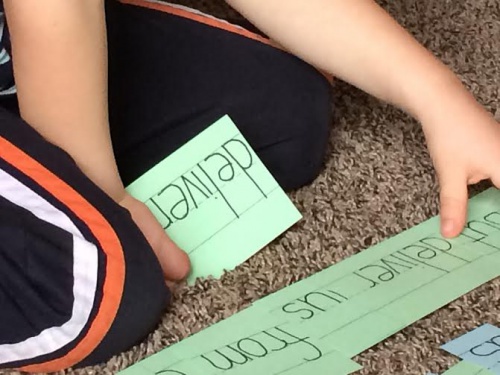The Doman Method for Teaching Reading during Early Childhood

Reading and writing are the main abilities that distinguish humans from any other living being. These two activities are the key tools with which we develop our intellect. That’s why we want to offer you a practical guide to the Doman Method, which you can use to teach your child how to read from the age of 8 months.
A baby can actually begin to be stimulated by reading-related activities before their first year of age. This is the belief of Glenn J. Doman, the creator of the method who has turned the world upside down and astonished parents when they see that their children are able to absorb hundreds of words in a short time.
The Doman Method: the vocabulary of babies
Other researchers even claim that the vocabulary of babies can be enriched starting from the first month of their life, through reading them stories.
Babies may not understand the meaning of each word within the story at first. But once they store the information, it won’t be long before designate the corresponding relationships between these words and the world around them.
And this is precisely what the Doman Method is: to use everyday elements in the child’s life in order to teach them what the representation of each one of them is in words, through flashcards or small posters that will help them to form associations and to memorize how they are written.

Sounds like an incredible task, doesn’t it? The most skeptical people will think that this is impossible, because of the custom of teaching the alphabet to children before teaching words. And there lies the difference between the Doman method and other strategies, in which abstract knowledge is a starting point for learning, such as letters.
Doctor Doman’s approach to learning starts from the familiar, what the child knows, and then moves to the abstract. Children are eager to absorb information, knowledge, and new things. This approach takes advantage of the child’s learning speed,
The work of Glenn J. Doman is recognized worldwide thanks to the launch of a network of Institutes for the Achievement of Human Potential, based in the United States, which are dedicated to encouraging children to take full advantage of their cognitive, emotional, and physical abilities.
Let’s see what the Doman method specifically entails in order for our children to be able to learn how to read at an early age.
Key points of the Doman Method

Little capsules of knowledge. The method should be applied in small sessions that cannot exceed 10 minutes. If the child is younger than one year, it is best to spend just three minutes teaching them. The idea is for them not to get bored so that they remain actively interested. Three sessions are done daily, and a new group of words is included each day.
These little details will make a big difference. If your child is under 18 months of age, the cards that you use will be large (15 x 60cm), the letters will be 12 cm high, and 2 cm thick, the words should be printed in red, and the cards must be placed 45 cm away from your baby.
For children who are over a year-and-a-half of age, the cards will be a little bit smaller (10 x 60 cm), the letters will now be black, and they will have a height of 7.5 cm, and be 1 cm thick, and you should place them one meter away from the child.
The Doman Method is fun
Do not treat this task as an obligation, because the fun tone of the sessions will help your children stay attentive and want to learn more.
Organization and discipline. Set groups of words by category (family, house, body parts). Each one should contain five words, one on each card. On the first day, you will show your child one category, but on the second day you need to include another group and you’ll have 10 cards. The third day you will add another category, for a total of 15 words.
Next, you will add a group every day until you reach the fifth day, when you’ll be using 25 words during each of the three daily sessions. On the sixth day, you will have to discard the first group of words and add another to keep the 25 cards.
This way, each group of words will be introduced to your child for five days, in 15 sessions, enough time for them to memorize each one of them.
In the beginning, you can make about 200 cards with which you will have material for a month of sessions. Remember that you must teach three small classes daily, and make them fun, and they can be done in any area of the house, while waiting in the doctor’s office, or wherever you want.
You and your child should have fun while they learn.
Go from familiar concepts to abstract ones. Start by teaching your child the words that define their environment: bottle, Dad, Mom, water, bed, hand, nose.
After you have gone through categories referring to your family environment, you can include other words associated with other environments such as the park, school, and their grandmother’s house. So their vocabulary will gradually expand to include your family’s names, colors, and everything you can think of.
Learning new words
Every time you teach a new word, try to point out to your child what object you are talking about. This will help them to make connections and it will be even easier for them.
The idea of this method is to go from what is familiar, for them to understand how words are written, to the abstract, understanding what is represented by the letters and the sounds. When your child understands what a word is, it will be easier for them to grasp the name of each letter and how syllables, words and phrases are formed.
If you put these instructions into practice, you will see that the Doman method will not only be an opportunity to get your child started with reading and writing, but it also gives you time with them to share and enjoy, while stimulating their intelligence. Don’t be afraid to give it a try, confidence will help you convey knowledge to your child.
So, go ahead!
All cited sources were thoroughly reviewed by our team to ensure their quality, reliability, currency, and validity. The bibliography of this article was considered reliable and of academic or scientific accuracy.
- Díaz, J. Q., & Llamas, J. L. G. (2013). Sobre el Aprender a leer. Acerca de las inquietudes que suscita la elección de un método para enseñar a leer. Libreria-Editorial Dykinson.
- Fundación Iberoamericana Down 21. (s. f.). Método Doman. Recuperado 2009, julio 17, de: http://www.down21.org/educ_psc/educacion/tecnica_inetrvencion/doman.htm
- Mejía, D. N. (2010). Lectura en pañales para llegar a la escuela. Revista Latinoamericana de Ciencias Sociales, Niñez y Juventud, 8(2), 873-883. https://dialnet.unirioja.es/servlet/articulo?codigo=3356276
- Suárez, L. B., & Carbajal, K. C. (2012). Aplicación del Método Doman para disminuir la dislalia funcional en niños de 5 años de la institución educativa Nº 252 “Niño Jesús” del distrito de Trujillo, 2012. Perspectivas en primera infancia, 1(1).
- Valadez, Á., Ángel, M., Gómez Zermeño, M. G., & García Mejía, I. A. (2013). Diseño de un recurso educativo multimedia basado en la Metodología Doman para mejorar la enseñanza de la lectura en el nivel preescolar. http://repositorio.minedu.gob.pe/handle/123456789/2865
This text is provided for informational purposes only and does not replace consultation with a professional. If in doubt, consult your specialist.
